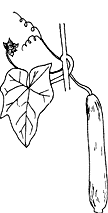View crop
View crop Data sheet EcoPortLuffa cylindrica
 |
|
| Notes |
|---|
| BRIEF DESCRIPTION A vigorous, climbing herb, with a square stem and tendrils up to 10 cm long. The leaves have a rough surface and may be up to 25 cm x 25 cm. The flowers are yellow and up to 10 cm in diameter. The fruit has 10 furrows on the surface and is 30-60 cm long and 8-12 cm in diameter. USES The fruits are eaten fresh or cooked as a vegetable and used in soups. The fibrous network of the fruit serves as a sponge used as a filter. Also table mats, insoles, sponges, sandals, shock-absorbing material and gloves are made from it. An edible oil is extracted from the seeds. GROWING PERIOD Annual herb, growing 70-80 days from transplanting to immature fruit and 100-120 days for mature fruit. COMMON NAMES Smooth loofah, Dish-cloth gourd, Sponge gourd, Rag gourd, Vegetable sponge, Jhinga Turai, Dhundal, Mozhuku, Peerkankai, ketola manis, Pikku, Pichukku, Patola, Shui kwa, Luffa, Loofah. FURTHER INF Smooth loofah probably originated in India. It is normally grown at elevations up to 1000 m. Yields of up to 30-40 t/ha or 20-25 fruits per plant have been recorded. Mentioned as a useful agroforestry species. | Sources |
| SOURCES (L. cylindrica (L.) M.J. Roem) Tindall H 1983 pp 176-179 [TEMP, RAIN, FER, DRA, PH] Purseglove J 1974 pp 129 [RAIN, FER, DRA, TEXT] Duke J 1975 pp 20 [PH, RAIN, TEMP] Rice R 1990 pp 258-259 [USE] Roecklein J 1987 pp 310 [USE] |